To find out more...
Who's making the croissants?
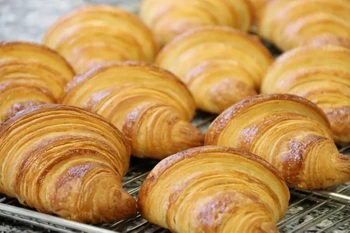
It's very often like that, with each of these professions having quite different ways of working, but sometimes there's also one or more people who have a slightly transversal role: the touriers.
Let's see who they are.
Trades and atmosphere
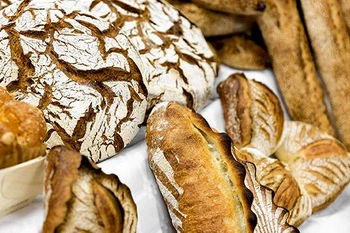
The baker kneads a lot and works with "leavened" doughs, which contain yeast or sourdough.
He needs a slightly warm atmosphere, not cold, for his doughs to rise properly.
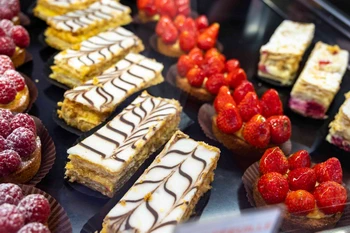
The pastry chef uses little or no kneading, no yeast or sourdough, and lots of butter, cream and eggs.
His doughs or creams require a cool, even chilly, atmosphere.
This difference gives rise to a well-known adage in the trade: "The baker closes the bakery door all the time, while the pastry chef opens it as soon as possible".
And the tourier?
In addition to these two professions, there's also the tourier, who takes care of all the doughs that need turning.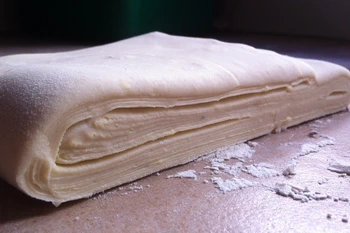
Giving a pastry a turn means folding it in on itself, even though it's made up of a layer of butter enclosed between 2 layers of pastry.
This is of course the case with puff pastry, but also and above all with croissant pastry or puff pastry (croissant dough).

So that's what the tourier's job is: they give the rounds, and they take care of all the products in this model, especially the viennoiserie.
So he's the one who makes croissants, pains au chocolat, raisin bread, etc.
In practice, it often happens that the tourier is also in charge of foncer, i.e. he or she rolls out the shortbread or sweet dough and lines the molds for the tarts and tartlets that the pâtisser will then line.
According to professional terminology, "the tourier prepares all types of dough for viennoiseries, tarts, savory and sweet puff pastries. He applies the techniques of melting, shaping and making the most common creams and fillings".
The rolling mill
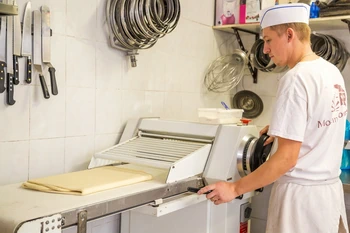
It's a lot of work to give a dough its turns, and of course the tourier doesn't work with a rolling pin like we do at home, he uses a machine all the time to roll out his dough, making it go back and forth between 2 metal rollers with adjustable spacing.
But the rolling machine isn't everything, and you also need a certain amount of experience to appreciate the dough's behavior, its level of fermentation, its temperature, its toughness, etc.
Training
As you can see, tourier is a real profession, with complex aspects that require real know-how, and it's a skill sought after by bakeries.
Part of the training for bakers (a lot) and pastry chefs (a little) includes a tourage component, which means that both can be involved in tourage in addition to their traditional duties.
The profession, which for a long time was on the wane, unfortunately torpedoed by frozen Viennese pastries, is now coming back with a vengeance, thanks to specialized training and the growing needs of bakeries for quality products and a high level of kneading.
To sum up: Who makes croissants in a bakery? It's the tourier, the specialist in puff pastry and the use of the rolling mill.
Butter vs. grease
We often read in a recipe where a pastry is put into a mould that, just before pouring, the mould should be buttered or greased. But what's the difference between these 2 terms?December 1st 20257315
Getting out of the fridge early
Very often when you're cooking, you need to take food or preparations out of the fridge, to use them in the recipe in progress. There's nothing tricky about this: you just take them out of the fridge and use them, usually immediately, in the recipe. But is this really a good method?November 24th 20259845
Oven height
When we put a dish or cake in the oven, we naturally tend to put it on the middle shelf, and that's what we usually do. But in some cases, this position and height can be a little tricky, so let's find out why.October 8th 20252,5065
The importance of sieving
In recipes that use a fine powder (flour, powdered sugar, etc.), you'll often see the advice to sift before using it. To sift is to pass the powder in question through a sieve (a very fine strainer) before incorporating it into your recipe. It's often advice, but is it really useful?September 3rd 20257,3793
The grease spray
As soon as you have something in a recipe that sticks to the mold, the question always arises as to how difficult it is to remove from the mold. There's nothing more frustrating than breaking your cake when unmolding it, because part of it has stuck in the mold. The classic way to avoid this is...August 26th 20256,9325
Getting out of the fridge early
Very often when you're cooking, you need to take food or preparations out of the fridge, to use them in the recipe in progress. There's nothing tricky about this: you just take them out of the fridge and use them, usually immediately, in the recipe. But is this really a good method?November 24th 20259845
Butter vs. grease
We often read in a recipe where a pastry is put into a mould that, just before pouring, the mould should be buttered or greased. But what's the difference between these 2 terms?December 1st 20257315
Oven height
When we put a dish or cake in the oven, we naturally tend to put it on the middle shelf, and that's what we usually do. But in some cases, this position and height can be a little tricky, so let's find out why.October 8th 20252,5065
The grease spray
As soon as you have something in a recipe that sticks to the mold, the question always arises as to how difficult it is to remove from the mold. There's nothing more frustrating than breaking your cake when unmolding it, because part of it has stuck in the mold. The classic way to avoid this is...August 26th 20256,9325





